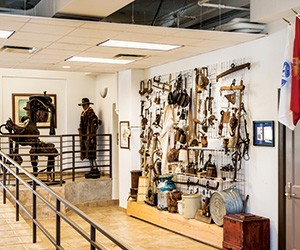<p>Created by legendary Austin advertising agency GSD&M (also behind “Don’t Mess With Texas”), the enduring “Texas: It’s Like A Whole Other Country” tourism tagline speaks powerfully to the Lone Star State’s vast scale, unique identity and singular place in the American experience. Only Texas, after all, has flown six different flags, starting with Spain in 1519.</p><p>In the spirit of the slogan, Texas could also be described as being like “a whole bunch of other countries” for its diversity of identifiable ethnic groups. Foremost, of course, were the Native Americans, the first people to experience the Spanish arrival. Credit these colonizers with introducing future defining Texan brand stamps: cattle and cowboys.</p><div style="clear: both; float: right;"><div id="callout_style_0" class="sidebar_related_article"><h2>More Coverage</h2><ul><li><a href="/ArticleDetails/tabid/162/ArticleID/24384/Default.aspx" target="">Texas draws delegates from around the globe</a></li></ul></div></div><p>The French were also early claimants to Texas (1685), followed by other Europeans. The first Polish colony in the U.S. was established at Panna Maria, near San Antonio, in 1854, around the time Germans and Czechs were finding central Texas en masse. Arrivals today, meanwhile, hail from Iran, Cambodia, Vietnam, India and Africa, to say nothing of Texas’ global tourism appea).</p><p>What is it to be Texan? As groups will discover through the following experiences and venues, the answer has many faces.</p><p><strong>Stirring the Pot</strong><br>
With its blend of Spanish, Mexican and German heritage, San Antonio embodies the layers laid down in Texas through the centuries. Earlier this year, the city’s five famed <a href="http://www.nps.gov/saan" target="_blank">Spanish missions</a> were nominated for UNESCO World Heritage status.</p><p>Representing the largest collection of Spanish Colonial architecture in North America, Mission Concepcion, Mission San Jose, Mission San Juan, Mission Espada and Mission San Antonio de Valero, better known as the Alamo, were built in the early 1700s to convert Native Americans to Christianity and establish Spain’s sovereignty in the region. Now linked by the new Mission Reach extension of River Walk, these treasures date to the original melting pot of Western, Latino and European cultures that spread across Texas and the U.S.</p><p>Politics related to Palestine’s membership in UNESCO remain an obstacle, but if successful, the missions’ inscription would make them the first UNESCO-protected site in Texas.</p><p><span class="page-break">PageBreak</span></p><p><strong>Human Resources</strong><br>
Also in San Antonio, the Smithsonian-affiliated Institute of <a href="http://www.texancultures.com" target="_blank">Texan Cultures</a> offers deep insight into the many different immigrant groups from around the globe that settled in Texas. Located in HemisFair Park near the convention center, the venue also offers versatile indoor and outdoor space for meetings and events. In Houston, meanwhile, groundbreaking begins soon on <a href="http://www.naucenter.org" target="_blank">The Nau Center</a> for Texas Cultural Heritage, a new heritage tourism center scheduled to open in fall 2016 across from the George R. Brown Convention Center. In El Paso, plans call for the construction of a new $5.8 million Hispanic Cultural Center under the city’s $500 million quality of life bond.</p><p><strong>Willkommen, Czech In</strong><br>
Rolling westward of Austin and San Antonio, Texas Hill Country is home to original German settlements such as New Braunfels, site of the annual <a href="http://www.wurstfest.com" target="_blank">Wurstfest</a>. Founded in 1961, this 10-day celebration of beer, sausage and German ancestry takes place each year in late October or early November.</p><p>German heritage is celebrated year-round in charming Fredericksburg (1846), where groups can tour the city’s National Historic Register-listed district and original sites such as the event-capable <a href="http://www.pioneermuseum.net" target="_blank">Pioneer Museum Complex</a>.</p><p>Founded in 1849, the hamlet of <a href="http://www.luckenbachtexas.com" target="_blank">Luckenbach</a> features live music at its legendary dance hall, while in the heart of its namesake town, <a href="http://www.gruenehall.com" target="_blank">Gruene Hall</a>, built in 1878, is Texas’ oldest continually operating dance hall.</p><p>East of Hill Country, historic Fayette County is considered the “Cradle of Czech Immigration,” the period between 1853 and around 1912 when arrivals from the former Austro-Hungarian Empire descended on the area. Here, in La Grange, groups can say “vitame vas” (“howdy,” roughly, in Czech) to the multifunctional <a href="http://www.czechtexas.org" target="_blank">Texas Czech Heritage and Cultural Center</a>, which includes a museum, Czech village and 400-seat auditorium. Planners may also rent space at the <a href="http://www.czechcenter.org" target="_blank">Czech Center Museum</a> in Houston.</p><p><span class="page-break">PageBreak</span></p><p>Arlington-area groups can buy Soviet-era memorabilia and eat hearty Russian fare at <a href="http://www.tasteofeuropetx.com" target="_blank">Taste of Europe</a>, which accommodates events.</p><p><strong>Buffalo Proud</strong><br>
A number of accounts record the arrival in 1528, possibly by shipwreck, of an African-born Spanish slave named Estevanico in modern-day Galveston. Thus began the African-American influence in Texas, most heroically illustrated by the Buffalo Soldier.</p><p>Before and after the Civil War, the U.S. government built frontier forts across the West to shield settlers from Native Americans and other people upset with their advance. Manning these defenses were African-American soldiers called “Buffalo Soldiers” by Plains Americans, by some accounts because their hair appeared buffalo-like. Origins aside, thousands of these brave cavalrymen—and their successor regiments all the way to the Korean War—went above and beyond the call of duty.</p><p>Their memory is enshrined at the event-capable <a href="http://www.buffalosoldiermuseum.com" target="_blank">Buffalo Soldiers National Museum</a> in Houston and at heritage sites such as <a href="http://www.fortconcho.com" target="_blank">Fort Concho National Historic Landmark</a> in San Angelo.</p>


